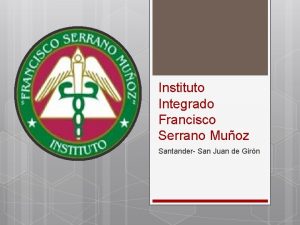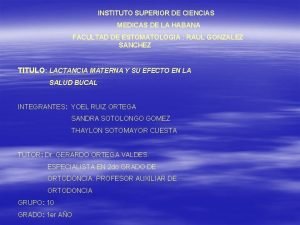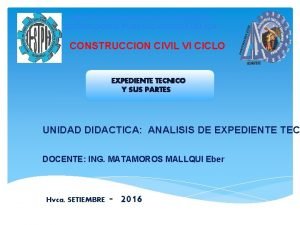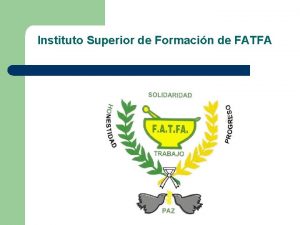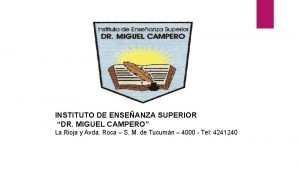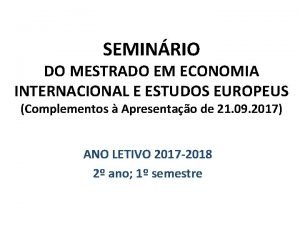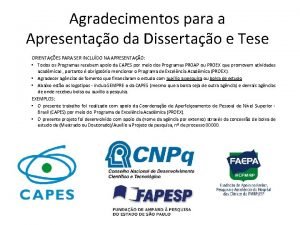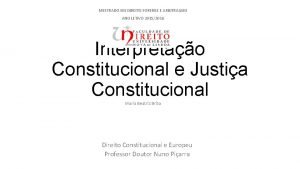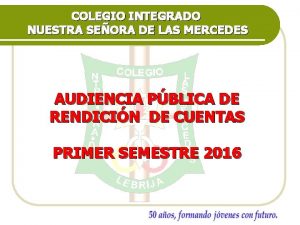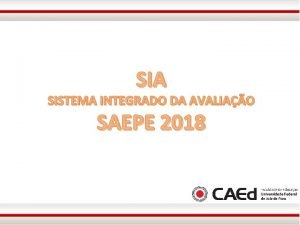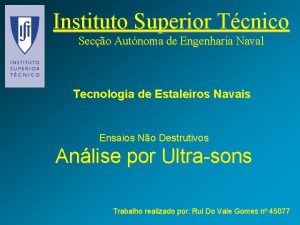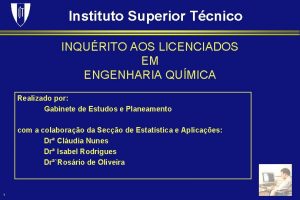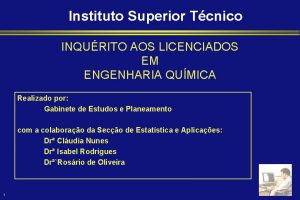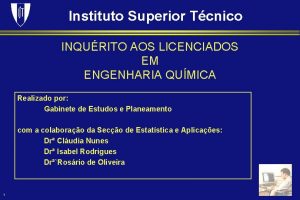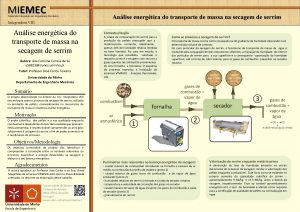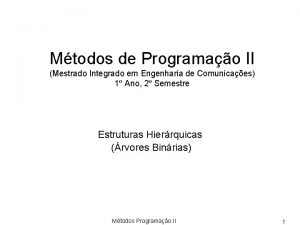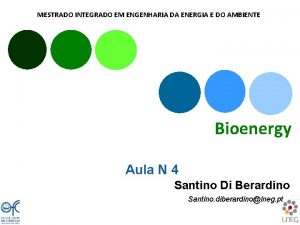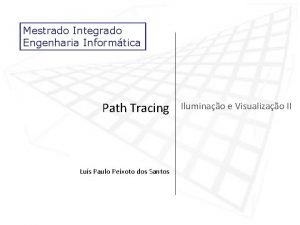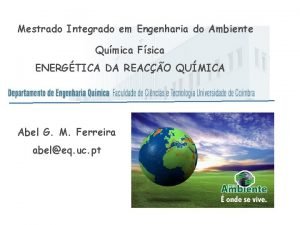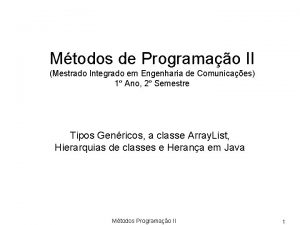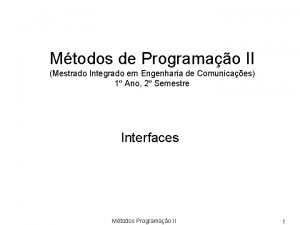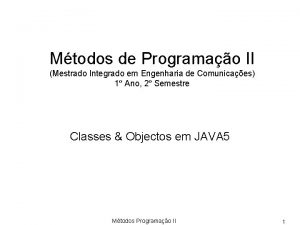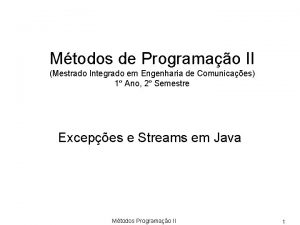INSTITUTO SUPERIOR TCNICO Mestrado Integrado em Engenharia Fisica

















- Slides: 17

INSTITUTO SUPERIOR TÉCNICO Mestrado Integrado em Engenharia Fisica Tese de Mestrado, Dezembro 2012 Control and command of non-powered liftenabled vehicles in planetary atmospheres. João Luis Pinto da Fonseca Presidente de júri: Prof. Carlos Renato de Almeida Matos Ferreira Orientador: Prof. Rui Manuel Agostinho Dilão Co-orientador: Prof. Ana Maria Ribeiro Ferreira Nunes Vogal: Prof. Luís Manuel Braga da Costa Campos Vogal: Prof. José Manuel Gutierrez Sá da Costa 1/17

Spacecrafts: Two different ways of reentering Earth’s atmosphere “Ballistic” Soyuz (Russia) Travelling from altitudes of 120 km (Earth’s atmosphere limit) Shenzhou (China) “Lift-Enabled” Space Shuttle (US) X-37 (US) Dragon (Space X-US) Apollo (US) X-37 B (US) 11 th Dec 2012 Range Tens of Kms Hundreds of Kms Flight Time Minutes Tens of Minutes Accelerations Up to 8 -10 g´s Up to 2 -4 g´s Flight Angle Steep Wide Landing scheme Parachutes, Rockets Gliding (no fuel!) 2/17

Command & Control: The difference between being dynamic or not! “Spirit” & Opportunity : Mars 2004 (7 minutes) “Curiosity”: Mars 2012 (7 minutes) 1 2 1 3 2 3 Hard Landing Soft Landing 3/17

Dinamically controlling the TAEM phase of the Space Shuttle’s atmospheric reentry (h 0~40 km) Main Assumptions • Flat 1 non moving earth • Constant mass with no Thrust • Glider is a mass point with Lift and Drag Derived Model Equations of Motion New coordinate system • Spheric coordinates for the velocity (not on the position!) Using a specific reality Control Variables Attack Angle Bank Angle • Structural limits of the Space Shuttle • Wind Tunnel data for the Space Shuttle (up to 5 Mach, adequate to TAEM) • Earth’s atmospheric profile (US 1976) 1 40 km altitute vs 6. 4 x 103 km for Earth radius 4/17

Using a specific reality: Earth’s Atmosphere (US 1976) Temperature Not Constant Density Sound Speed Not constant (impacts on Ma) Pressure “Almost” exponential 5/17

Using a specific reality: Structural Limits Heat Flux Limiting Factor: Shuttle Nose (smallest curvature) Result: Imposes a minimum attack angle Load Limiting Factor: Shuttle Wings (biggest surface) Result: Imposes a maximum attack angle Acceleration Limiting Factor: Cargo and human occupants (not the fuselage) Result: Imposes a “smoothness condition” on the speed of the Space Shuttle 6/17

Space Shuttle´s Heat Insulation Numbered Tile System 7/17

Using a specific reality: Wind tunnel data for the Space Shuttle A “window of opportunity”. Can not go down too steep nor too shallow Aerodynamic Coefficients Key angles for the control “No Lift” attack angle: When lift is null (independent of Mac number) “Max Glide” attack angle: When L/D is max (maximizes range travelled) “Stall” attack angle: When lift peaks (and the induced drag also!) 8/17

Equations of Motion: Basic Dynamics Phase Space • 1 fixed point (or limit cycle) for each combination of relevant parameters • Stable fixed points (negative eigenvalues for all situations) • Different convergence regimes for different situations (to “roll or not to roll” around the fixed point) Fixed Point (or limit cycle) • • Earth profiles: g, ρ, Vsound (Ma) Areodynamic: CL and CD (α, Ma) Vehicle parameters: m, S Controls: α and μ Conceptual graph for CL=CD=1 and g=9. 8 m/s 2 Dynamics Space Shuttle case • “Rolled convergence” or “Straigh-line” converge to the fixed point (or limit cycle) 9/17

Algorithm: Minimize distance subject to aerodynamic & structural contraints Attack Angle Bank Angle • Heading Control (base control) • Heat Flux Control (if needed: imposes minimum angle) • Anti-Stall Control (if needed: forces a curved approach) • Load Factor Control (if needed: imposes maximum angle) • Energy Control (if needed: forces a dynamic S-turn to prevent climbs) • Heat and load controls only intervene should heading try to breach limits • Anti-stall and energy only intervene should heading try to breach limits 10/17

Simulations: From 30, 000 m to 3, 000 m (TAEM phase) Initial Conditions Analysis Made 1 • Range and error reaching specific targets at 3, 000 meters Physical Constraints Algorithm’s Parameters 2 • Typical trajectories generated by the algorithm 3 • Sensitivity analysis to initial conditions and control time interval 4 • Structural limits check on excessive speed entries 11/17

1 Simulations: TAEM Range and Error reaching the target point (HAC) Maximum Range • Hundreds of kilometers of range in any direction (highest range for straight flight) • Symmetric ranges for symmetric alignments with initial velocity • Different ranges for different alignments with initial velocity Distance Error • Typical error of the order of magnitude of 100 meters or below • Confirmation that any point inside MR is achievable (small error) • Angular symmetry of the error distribution follows the angular symmetry of the range 12/17

Simulations: Typical Trajectories 2 Long Range Trajectory • When the flight is made mostly in straight line (typical Shuttle strategy) Short Range Trajectory • When the HAC is “too close” to the xy origin the algorithm initiates a whirlpool approach while the altitude “slowly” decreases • Changed: HAC position Possible through dynamic S-turns Excessive Energy Trajectory • Without the energy control (dashed) we have caotic trajectories and the HAC is NOT reached • Changed: 3, 300 m/s entry speed 13/17

Simulations: Long Range Zoom-in 3 Almost always at equilibrium (v=v*) Speed and forces History Initial condition quickly changed Commands History Final approach Maximum glide until reachable in straight-line Diminishing turn Sonic boom 14/17

Simulations: Sensitivity Analysis 4 Initial Energy • Crucial to have enough speed to reach the target Initial Orientation • Crucial to start with the “right” trajectory descent angle (γ) Control Time • Selfrecovering • Low errors up to 30 seconds of control time interval 15/17

Simulations: Structural limits check Thermic • Three different initial speeds (V 0=1, 100 m/s; V 0=1, 650 m/s; V 0=2, 200 m/s) Mechanical • Three different initial speeds (V 0=1, 100 m/s; V 0=1, 650 m/s; V 0=2, 200 m/s) Maximum temperature for highest entry speed Maximum load for highest entry speed Maximum flux for highest entry speed Maximum g’s for highest entry speed 16/17

Conclusions & Next Steps Conclusions • The algorithm works well with control times intervals up to 30 seconds and is by nature self-recoverable at all control times • Any point inside the Maximum Range curve can be reached with minimum error (around or below 100 meters) • Three main types of trajectory are designed dependent on the HAC distance (close or far) and whether or not the glider has excessive speed • Sensitivity to initial conditions is limited and the glider will always reach the HAC should the initial speed be enough and the trajectory angle γ adequate Next steps Improve Extend Upgrade Lower Error reaching HAC Higher Speeds (up to 30 M) HAC Velocity Direction Landing maneuvers Thurst (and variable mass) Moving Non-Flat Earth & Wind 17/17
 Instituto integrado francisco serrano muñoz
Instituto integrado francisco serrano muñoz Instituto de formacion docente santa maria
Instituto de formacion docente santa maria Instituto superior de ciencias medicas de la habana
Instituto superior de ciencias medicas de la habana Instituto tecnologico huancavelica
Instituto tecnologico huancavelica Instituto superior tecnológico cepea
Instituto superior tecnológico cepea Escuela preparatoria instituto superior benjamín franklin
Escuela preparatoria instituto superior benjamín franklin Iscs - instituto superior de ciencias de la salud
Iscs - instituto superior de ciencias de la salud Instituto fatfa
Instituto fatfa Tecnologico de mulege
Tecnologico de mulege Instituto superior de teologia aplicada
Instituto superior de teologia aplicada Escuela campero tucuman
Escuela campero tucuman Passei no mestrado
Passei no mestrado Mestrado em economia internacional
Mestrado em economia internacional Agradecimento a capes dissertação
Agradecimento a capes dissertação Mestrado utfpr londrina
Mestrado utfpr londrina Mestrado em direito forense e arbitragem
Mestrado em direito forense e arbitragem Colegio integrado nuestra señora de la paz
Colegio integrado nuestra señora de la paz Sia.caedufjf.net aplicador
Sia.caedufjf.net aplicador
